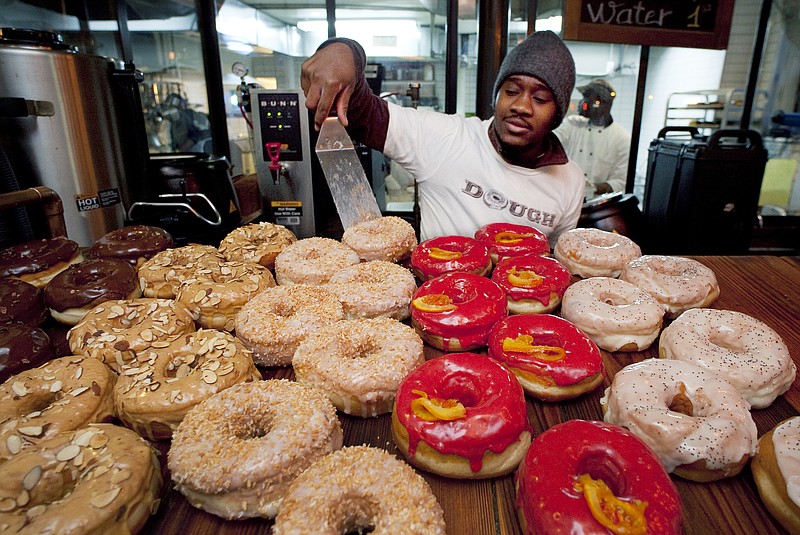By CHRISTOPHER S. RUGABER and DEREK KRAVITZ
AP Economics Writers
WASHINGTON - Steady declines in applications for unemployment aid are pointing to another strong month of hiring in February.
A healthy job market normally drives faster growth. But Americans' after-tax income adjusted for inflation actually fell in January, which led to a fourth straight month of weak consumer spending.
The mixed data highlighted a flurry of reports Thursday that suggest the recovery will stay bumpy. Manufacturing growth slowed and construction spending dipped, while auto and retail sales both climbed.
Consumers are also being hit with higher gas prices that are only expected to rise further in the coming months.
"The rise (in incomes) was reasonable but given the strong job gains, I was hoping that the increases in wages and salaries would be a bit greater than they were," said Joel Naroff, chief economist for Naroff Economic Advisors. "Still, this source of funds is on the rise so that is good news."
Jennifer Lee, an economist at BMO Capital Market, put it more bluntly: "Stronger job creation is not generating more spending."
Weekly applications for unemployment benefits dipped last week to a seasonally adjusted 351,000, the Labor Department said. And the four-week average of applications, which smooths out weekly fluctuations in the data, fell to 354,000. Both are the lowest levels in four years.
Applications for unemployment aid have fallen steadily since the early fall and are down nearly 15 percent since October. When applications drop consistently below 375,000, it usually signals that hiring is strong enough to lower the unemployment rate.
Many economists predict employers added more than 200,000 net jobs in February for the third straight month.
"The labor market appears to have strengthened markedly over the last few months," said Paul Ashworth, senior U.S. economist for Capital Economics. Ashworth predicts the economy added 220,000 net jobs last month and the unemployment rate fell for the sixth straight month, to 8.2 percent.
Consumer spending increased 0.2 percent in January, the Commerce Department said. That's better than December's reading of no change. And income rose 0.3 percent, the second straight monthly increase.
Still, after paying taxes and adjusting for inflation, incomes actually dipped in January. That reflected a big increase in tax payments last month.
At the same time, inflation-adjusted spending was flat for the third straight month. That was partly because of warmer weather, which allowed people to spend less to heat their homes.
Strong hiring in December and January, rather than pay raises, helped boost income. That trend may fuel more consumer spending and support solid growth for the economy in coming months. Consumer spending accounts for 70 percent of economic activity.
Manufacturing activity grew more slowly in February, according to the Institute for Supply Management's monthly index. U.S. factories received fewer new orders and paid higher prices for raw materials.
The ISM index fell to 52.4, the lowest reading since November. But that followed three straight monthly increases. Any reading above 50 indicates growth. By that measure, manufacturing has grown for 31 straight months.
The report "is hardly a disaster, but it does support our view that the economy is not quite as strong as recent data have led others to believe," said Paul Dales, senior U.S. economist with Capital Economics, in a note to clients.
The building industry also cooled offed in January after five straight months of gains in construction spending.
A big drop in commercial building projects, such as factories, hotels and power plants, caused a slight decline, the Commerce Department said. But the dip comes after previous monthly figures were revised much higher.
One bright spot in the economy has been rising auto sales, and most automakers said February was no different.
Americans purchased smaller, fuel-efficient cars to offset rising gas prices. Volkswagen and Nissan reported double-digit sales increases. Even General Motors, which pulled back on its deep discounts, saw a slight gain.
Many retailers also reported strong sales gains in February, including Target Corp., Macy's Inc. and Limited Brands Inc., which exceeded Wall Street estimates. Even long-struggling Gap Inc. managed better sales figures due to strong demand for spring clothing at its Banana Republic chain.
Most economists expect growth should rise to 2.5 percent this year. That would be healthy in most years but is modest coming after the worst recession since World War II.
